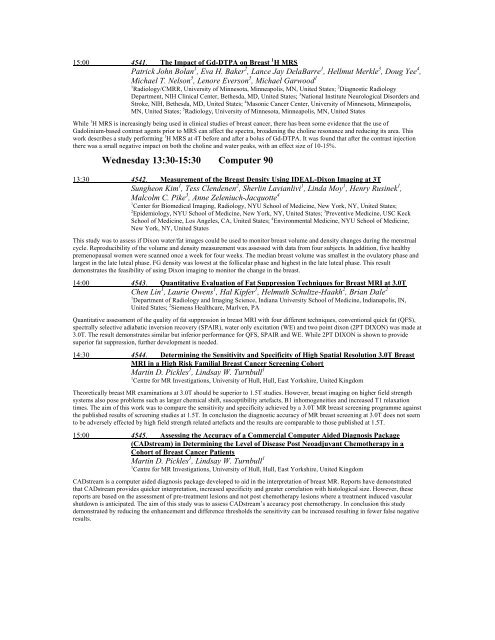ELECTRONIC POSTER - ismrm
ELECTRONIC POSTER - ismrm
ELECTRONIC POSTER - ismrm
Create successful ePaper yourself
Turn your PDF publications into a flip-book with our unique Google optimized e-Paper software.
15:00 4541. The Impact of Gd-DTPA on Breast 1 H MRS<br />
Patrick John Bolan 1 , Eva H. Baker 2 , Lance Jay DelaBarre 1 , Hellmut Merkle 3 , Doug Yee 4 ,<br />
Michael T. Nelson 5 , Lenore Everson 5 , Michael Garwood 1<br />
1 Radiology/CMRR, University of Minnesota, Minneapolis, MN, United States; 2 Diagnostic Radiology<br />
Department, NIH Clinical Center, Bethesda, MD, United States; 3 National Institute Neurological Disorders and<br />
Stroke, NIH, Bethesda, MD, United States; 4 Masonic Cancer Center, University of Minnesota, Minneapolis,<br />
MN, United States; 5 Radiology, University of Minnesota, Minneapolis, MN, United States<br />
While 1 H MRS is increasingly being used in clinical studies of breast cancer, there has been some evidence that the use of<br />
Gadolinium-based contrast agents prior to MRS can affect the spectra, broadening the choline resonance and reducing its area. This<br />
work describes a study performing 1 H MRS at 4T before and after a bolus of Gd-DTPA. It was found that after the contrast injection<br />
there was a small negative impact on both the choline and water peaks, with an effect size of 10-15%.<br />
Wednesday 13:30-15:30 Computer 90<br />
13:30 4542. Measurement of the Breast Density Using IDEAL-Dixon Imaging at 3T<br />
Sungheon Kim 1 , Tess Clendenen 2 , Sherlin Lavianlivi 1 , Linda Moy 1 , Henry Rusinek 1 ,<br />
Malcolm C. Pike 3 , Anne Zeleniuch-Jacquotte 4<br />
1 Center for Biomedical Imaging, Radiology, NYU School of Medicine, New York, NY, United States;<br />
2 Epidemiology, NYU School of Medicine, New York, NY, United States; 3 Preventive Medicine, USC Keck<br />
School of Medicine, Los Angeles, CA, United States; 4 Environmental Medicine, NYU School of Medicine,<br />
New York, NY, United States<br />
This study was to assess if Dixon water/fat images could be used to monitor breast volume and density changes during the menstrual<br />
cycle. Reproducibility of the volume and density measurement was assessed with data from four subjects. In addition, five healthy<br />
premenopausal women were scanned once a week for four weeks. The median breast volume was smallest in the ovulatory phase and<br />
largest in the late luteal phase. FG density was lowest at the follicular phase and highest in the late luteal phase. This result<br />
demonstrates the feasibility of using Dixon imaging to monitor the change in the breast.<br />
14:00 4543. Quantitative Evaluation of Fat Suppression Techniques for Breast MRI at 3.0T<br />
Chen Lin 1 , Laurie Owens 1 , Hal Kipfer 1 , Helmuth Schultze-Haakh 2 , Brian Dale 2<br />
1 Department of Radiology and Imaging Science, Indiana University School of Medicine, Indianapolis, IN,<br />
United States; 2 Siemens Healthcare, Marlven, PA<br />
Quantitative assessment of the quality of fat suppression in breast MRI with four different techniques, conventional quick fat (QFS),<br />
spectrally selective adiabatic inversion recovery (SPAIR), water only excitation (WE) and two point dixon (2PT DIXON) was made at<br />
3.0T. The result demonstrates similar but inferior performance for QFS, SPAIR and WE. While 2PT DIXON is shown to provide<br />
superior fat suppression, further development is needed.<br />
14:30 4544. Determining the Sensitivity and Specificity of High Spatial Resolution 3.0T Breast<br />
MRI in a High Risk Familial Breast Cancer Screening Cohort<br />
Martin D. Pickles 1 , Lindsay W. Turnbull 1<br />
1 Centre for MR Investigations, University of Hull, Hull, East Yorkshire, United Kingdom<br />
Theoretically breast MR examinations at 3.0T should be superior to 1.5T studies. However, breast imaging on higher field strength<br />
systems also pose problems such as larger chemical shift, susceptibility artefacts, B1 inhomogeneities and increased T1 relaxation<br />
times. The aim of this work was to compare the sensitivity and specificity achieved by a 3.0T MR breast screening programme against<br />
the published results of screening studies at 1.5T. In conclusion the diagnostic accuracy of MR breast screening at 3.0T does not seem<br />
to be adversely effected by high field strength related artefacts and the results are comparable to those published at 1.5T.<br />
15:00 4545. Assessing the Accuracy of a Commercial Computer Aided Diagnosis Package<br />
(CADstream) in Determining the Level of Disease Post Neoadjuvant Chemotherapy in a<br />
Cohort of Breast Cancer Patients<br />
Martin D. Pickles 1 , Lindsay W. Turnbull 1<br />
1 Centre for MR Investigations, University of Hull, Hull, East Yorkshire, United Kingdom<br />
CADstream is a computer aided diagnosis package developed to aid in the interpretation of breast MR. Reports have demonstrated<br />
that CADstream provides quicker interpretation, increased specificity and greater correlation with histological size. However, these<br />
reports are based on the assessment of pre-treatment lesions and not post chemotherapy lesions where a treatment induced vascular<br />
shutdown is anticipated. The aim of this study was to assess CADstream’s accuracy post chemotherapy. In conclusion this study<br />
demonstrated by reducing the enhancement and difference thresholds the sensitivity can be increased resulting in fewer false negative<br />
results.
















